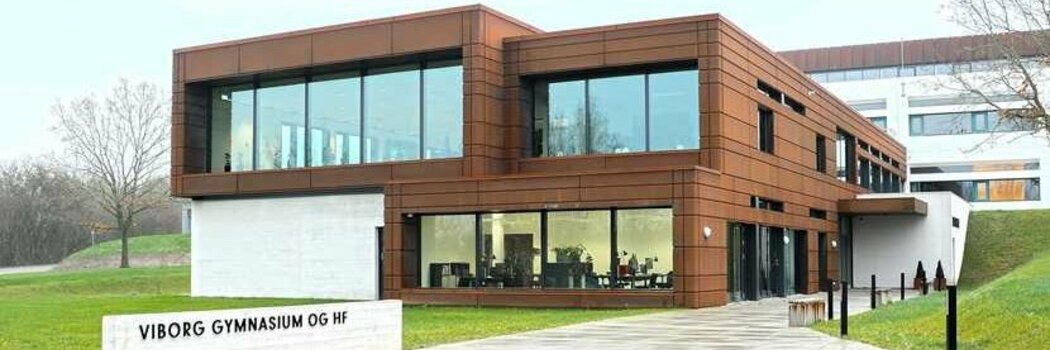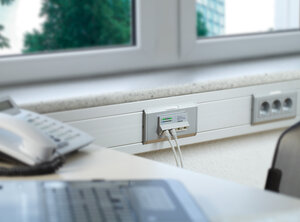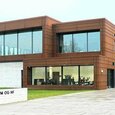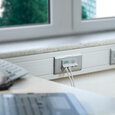
Green and cost-effective - Why Viborg Amtsgymnasium in Denmark opted for FTTO
The smart building structures of the future will require very comprehensive internal communication routes. This is especially true in educational institutions, where pupils and students use their PCs and tablets as interactive teaching platforms. If, as is the case at the brand new Viborg Amtsgymnasium, you need to give up to 1,400 students access to internet, intranet and interactive teaching, then it requires a very comprehensive communication infrastructure.
In construction, there is a lot of conventional thinking, also when it comes to the communication routes in buildings. Normally, an installation like the one at Viborg Amtsgymnasium's new buildings would be based on an HX server, which via an optical backbone and a number of UX distributors communicates to the individual users with twisted pair copper the last part of the way. But copper is actually both an expensive and environmentally damaging resource, and why use copper when fiber can solve the task at higher speeds, at a lower cost, more reliable - and ultimately also more environmentally conscious.
The use of fiber has changed from dealing with "the last mile" to becoming "the last metre". With the development of technology, splicing solutions and the components that are inside a fibre optic communication network, the fibre optic solutions are much easier to install than copper. And at the same time, fiber bypasses the speed and range constraints to which copper is subject - especially as a result of increased frequencies and data rates.

Saves money - and space
The quite extensive fibre optic network at Viborg Amtsgymnasium comprises a total of 400 micro switches. The installation was carried out by FiberMAN A/S, which - as the name indicates - specialises in fiber optics. The 400 micro switches delivered from German manufacturer MICROSENS through their Danish partner Wexøe A/S can each supply four outlets for computers or similar devices. In addition to the physical outlets, the micro switches also have a port for, for example, a WiFi access point, so that teachers and students can have wireless access to the school's network. The outlets also have two computer sockets and two standard 230VAC sockets.
Using fiber up to the end user eliminates four or five UX rooms that would otherwise have to be used for the somewhat space-consuming main distribution frames that copper installations would require for local conversion from fiber to copper and vice versa. Instead, pipes have been laid all the way from the HX server to the individual outlets, and the advantage of the fiber solution is, among other things, that the installer has been able to blow the fibre all the way through the installation to the place of use. And since you save the UX rooms, the freed up area can instead be used for teaching purposes, for example.
Due to the high data rates in a CAT6A installation, there is a natural limit to how far you can send the signal in copper connections - typically a maximum of 90 metres. That limit does not at all exist when using fiber. Moreover, it is also a more compact solution, as a main feed holds 24 pipes, each of which able to contain 12 fibres. As the pipes have an outer diameter of just Ø3 mm, the overall solution becomes extremely compact. In addition, optical communication is virtually lossless, so besides being a more practical solution, you also avoid having to dispose of the heat that is developed in copper-based communication solutions. This makes fiber optics a greener solution.
We have performed calculations on how much cheaper the installation at Viborg Amtsgymnasium has become in relation to the estimated contract price for a similar copper solution. As a whole, as much as 60 percent has been saved on installation costs. This is of course due to the easy way of blowing the fibres through the pipes, just as connecting the fibers in the MICROSENS micro switches is made easy with the use of the MICROSENS SFPs. So no tricky splicing work has to been done with the installation.

Far more robust solution
In just a few years, fiber optic communication has evolved from being a slightly exotic high-end solutions to becoming easy fiber to the office solutions with extremely reliable and robust operation. In a fiber optic assembly today, the loss is rarely more than 0.1dB. The communication between the server and the user outlets is thus largely lossless.
Fibre also has the advantage that damage only rarely affects larger areas. For example, if you lose the power supply to a UX main distribution frame, you might lose 20 to 25 percent of the capacity. In the case of the fibers, as a rule, only one pair of fibres will be destroyed, and this can be quickly restored.
However, Wexøe is surprised that the industry - and especially the construction industry - is not quicker to adopt fiber optic communication in connection with new constructions and reconstructions. Central Denmark Region in Jutland has, however, been very visionary, and they like to look over the shoulder at the good solutions from abroad. And why not? Fiber optics take up only a little space in the installation and require no brand space or contemporary factor. In addition, fiber optics will be able to keep up with technological developments a long way up the evolutionary ladder of data speeds. And finally, one must not forget that fiber as opposed to copper is a green solution, both in terms of production and operation. So in addition to a robust and affordable solution, you also do something good for the environment by choosing fiber over copper.
©Copyright Wexøe A/S
©iStock-828463842_AntonioGuillem / Three students together
A propos de MICROSENS
La transmission d'informations par des connexions à fibres optiques présente de nombreux avantages. MICROSENS GmbH & Co. KG l'a reconnu très tôt. L'entreprise, qui fait partie des pionniers, développe et produit des systèmes de communication et de transmission à haute performance en Allemagne depuis 1993. Adaptés individuellement aux exigences des différents domaines d'utilisation et intégrés dans des concepts globaux pour les différentes industries. Mais surtout, proche du client. Les défis techniques des projets des clients se répercutent directement sur le développement des produits. Il en résulte des solutions d'automatisation basées sur IP pour les bâtiments modernes, des concepts de réseau rentables pour les bureaux et les postes de travail, des solutions robustes et à sécurité intégrée pour les environnements industriels, des systèmes de transport optique pour les réseaux étendus d'avenir et la liaison efficace des sites et des centres de données.













